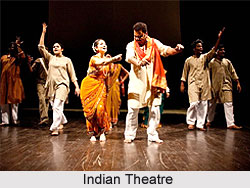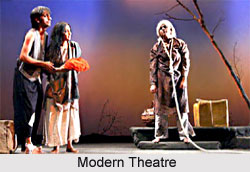 Contemporary Indian theatre has evolved a great deal from the days of inception. Theatre has always been a mirror for man, and Indian theatre has not been any different. Indian drama is a reflection of a man`s world of the eternal conflicts that plague him, and through which he has experienced a range of emotions. Man has created a very complex language called theatre, a language that actually has the ability to redefine the natural concepts of time, space and movement. It uses a language that goes beyond the verbal, a movement that goes beyond the physical. Through this language of theatre he has been able to see himself for who he is, what he has made of himself and what he aspires to be. Thus it becomes extremely crucial to do the type of theatre which has a point to make and is also engaging enough. Only then is there the true synergy between the artist and the audience. This synergy is better described in our traditional theatre as Rasa.
Contemporary Indian theatre has evolved a great deal from the days of inception. Theatre has always been a mirror for man, and Indian theatre has not been any different. Indian drama is a reflection of a man`s world of the eternal conflicts that plague him, and through which he has experienced a range of emotions. Man has created a very complex language called theatre, a language that actually has the ability to redefine the natural concepts of time, space and movement. It uses a language that goes beyond the verbal, a movement that goes beyond the physical. Through this language of theatre he has been able to see himself for who he is, what he has made of himself and what he aspires to be. Thus it becomes extremely crucial to do the type of theatre which has a point to make and is also engaging enough. Only then is there the true synergy between the artist and the audience. This synergy is better described in our traditional theatre as Rasa.
In a pluralistic society like ours which is culturally so diverse, and a civilization that is as antique as the world, it is very hard to define what is quintessentially Indian. Theatre culture in various parts of the country specially the quality of plays, scripts and acting showcased in Bengali theatre, Kannada Theatre, Malayalam theatre and Tamil theatre are indeed one of the best in the country. Apart from them Marathi drama and theatre and Gujarati theatre have also contributed significantly towards the betterment of the theatre culture in India.
 There are spaces that actually go beyond language and region, and they are the ones which are most useful. These are, as a matter of fact, more of ideological spaces and the whole purpose of making them is to come closer to the identity of India, its root and culture, rather than to create further hostile divisions. India as a nation has enough of such material. The three spaces in the context of Contemporary Indian Theatre can be described as the traditional, continual and radical respectively and none of these spaces are mutually exclusive.
There are spaces that actually go beyond language and region, and they are the ones which are most useful. These are, as a matter of fact, more of ideological spaces and the whole purpose of making them is to come closer to the identity of India, its root and culture, rather than to create further hostile divisions. India as a nation has enough of such material. The three spaces in the context of Contemporary Indian Theatre can be described as the traditional, continual and radical respectively and none of these spaces are mutually exclusive.
The traditional Indian theatre forms, with predominance in dance and songs, like Yakshagana, Swang, Nautanki and Tamasha have made a tremendous impact on the advancement of theatre in India. The word `Natya` is used for both Dance and Drama. In a Bharatnatyam concept, a varnam contains everything that theatre and dance all over the world strive for. It has grace and technique. It has power, it has emotions, dramatic tension, beauty, and most definitely it has style. A Rasika who has the capacity to enjoy this experience is truly a traditionalist in the best sense of the word.
It is absolutely vital to have tradition and continuity. The radical theatre of today is in all likelihood to become the traditional theatre of tomorrow. Some of the most powerful works in the field of Indian drama are from radicals like Rabindranath Tagore, Badal Sircar and Vijay Tendulkar. Tagore was among the first of the 20th Century dramatists to put the focus on the caste system and inequality through his plays.
One can have roots, and roots can grow into flowering trees. And on those trees are birds ready to spread their wings and fly. That is the completeness of life and its representative called theatre.




